Venus

Image of Venus and its clouds captured by Mariner 10 using an ultraviolet filter.
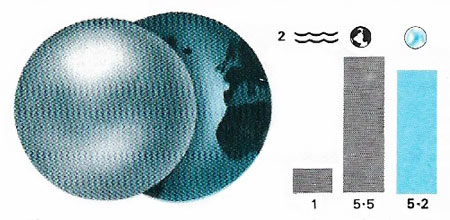
(1) Venus and Earth are almost equal in size, mass and surface gravity. (2) The density of Venus is less than Earth's, but it may have a heavy core.

The first view of the surface of Venus was sent back by the Soviet probe Venera 9 on 22 October 1975. It shows rough, angular rocks stretching to the horizon (crossing the top corners at an angle). Part of Venera can be seen at the bottom. Its detached density probe is arrowed. The scene was surprisingly bright: 'like a cloudy winter day in Moscow'. Venera 10 landed three days later, and found eroded pancake-like rocks.
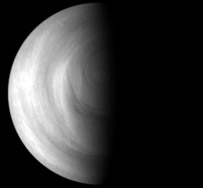
South polar region of Venus. Image in UV by ESA's Venus Express probe.
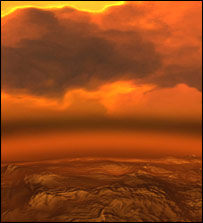
Artist's impression of the surface of Venus.

Venus atmosphere profile.
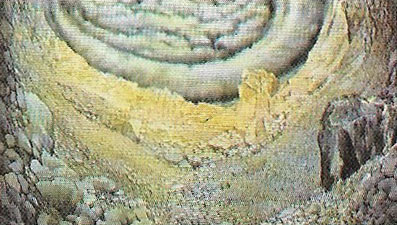
The dense atmosphere of Venus led scientists to believe that it must be 'super-refractive'; that is to say, the rays of light would be bent to such an extent that an observer on the planet's surface would have the impression of being in a vast bowl, with the horizon curving upwards all around them. However, the Venera 9 and 10 pictures showed that this is not the case. The atmosphere of Venus does not show the super-refraction that was forecast.
Venus is the second planet from the Sun and almost a twin of Earth in size. It is the brightest object in the sky after the Sun and the Moon, and is popularly known as the Evening Star or the Morning Star depending on when it is on view.
| mean distance from Sun | 108.2 million km (67.3 million mi, 0.723 AU) |
| equatorial diameter | 12,103.6 km (7,522.4 mi), Earth × 0.949 |
| mass (Earth = 1) | 0.815 |
| density | 5.25 g/cm3 |
| axial period | 243.0 days |
| axial inclination | 177.3° |
| orbital period | 224.7 days |
| orbital inclination | 3.4° |
| orbital eccentricity | 0.007 |
| number of moons | 0 |
| atmospheric composition | 96% carbon dioxide, 3.5% nitrogen |
| surface temperature (mean) | 464°C (867°F) |
| surface gravity (Earth=1) | 0.903 |
| escape velocity | 10.36 km/s (37,296 km/h, 23,180 mph) |
| albedo | 0.76 |
The term 'Cytherean' is used to describe something pertaining to Venus, e.g. Cytherean meteorology. It has also been used in science fiction and past scientific speculation to describe a hypothetical inhabitant of Venus. In mythology, Cythera is the Ionian island upon which the goddess Venus first set foot.
Venus has a slow retrograde (east-to-west) spin, opposite in direction to that of every other planet in the Solar System and presumably the result of a massive ancient collision. Venus is also the hottest planet – a result of of its dense atmosphere, predominantly of carbon dioxide, which traps the heat radiating from the surface. The runaway greenhouse effect on Venus gives rise to temperatures high enough to melt lead, while the weight of the atmosphere results in a surface pressure 90 times greater than that of Earth (equivalent to standing on the ocean floor at a depth of about 900 meters, or 3,000 feet). Due to the thermal inertia and convection of its atmosphere, Venus' surface temperature, averaging about 464°C (867°F) alters very little between the night and day sides of planet despite the extremely slow rotation.
| Venus and Earth compared | ||
|---|---|---|
| Venus | Earth | |
 |
 |
|
| distance from Sun | 108,200,000 km | 149,600,000 km |
| diameter | 12,103.6 km | 12,756.6 km |
| mass | 0.82 Earth masses | 1.0 earth mass |
| axial rotation period | 243 Earth days (retrograde) | 23 h 53 min |
| length of year | 224.7 Earth days | 365 days |
| atmosphere | 96% carbon dioxide 3% nitrogen |
77% nitrogen 21% oxygen |
| mean surface temperature | 464°C | 15°C |
| moons | 0 | 1 |
| global magnetic field | no | yes |
Atmosphere
Venus has a dense atmosphere, composed chiefly (96.5%) of carbon dioxide, which generates a surface pressure 90 times greater than that on Earth. This massive blanket of carbon dioxide is also responsible for a runaway greenhouse effect that heats the planet's surface to an average temperature of 467°C (872°F) – hot enough to melt lead.
Clouds on Venus also contain droplets of sulfuric acid along with compounds of chlorine and fluorine. These precipitate an acid rain called virga, which evaporates before it has the chance to reach the surface.
As Venus moves forward in its solar orbit while slowly rotating backwards on its axis, the top level of clouds zips around the planet every four Earth days, driven by hurricane-force winds traveling at about 360 kilometers per hour (224 mph). Atmospheric lightning bursts light up these quick-moving clouds. Speeds within the clouds decrease with cloud height, and at the surface are estimated to be just a few km/h.
| Atmospheric composition at surface level |
Major components (by volume) 96.5% carbon dioxide (CO2) 3.5% nitrogen (N2) Minor components (parts per million) 150 sulfur dioxide (SO2) 70 argon (Ar) 20 water vapor (H2O) 17 carbon monoxide (CO) 12 helium (He) 7 neon (Ne) |
| Surface pressure | 92 bars |
| Surface density | ~65 kg/m3 |
| Surface wind speeds | 0.3-1.0 m/s |
Early observations
That Venus was permanently enveloped in what appeared to be thick, white clouds soon became clear following the development of the telescope. By analogy with Earth, it was generally assumed that these clouds were made of water vapor, a conclusion supported by early spectroscopic studies by Secchi. The main composition of the atmosphere remained a matter for conjecture until spectroscopic observations by Walter Adams and Theodore Dunham, in 1932, established that it was carbon dioxide. Speculation about the make-up of the clouds continued. In 1937, R. Wildt suggested methanal (formaldehyde), while in 1954, Fred Whipple and Donald Menzel proposed ice crystals. Today, they are known to consist primarily of sulfuric acid.
Hydroxyl radical in Venusian atmosphere
In the May 2008 issue of Astronomy & Astrophysics, Picconi et al. report the first detection of the hydroxyl (–OH) radical in the night-side airglow emission of Venus. The discovery was made using an instrument onboard Venus Express. This is the first detection of –OH in the atmosphere of a planet other than Earth. It is important because it will give new insight into the dynamics of the upper atmosphere and the climate system of Venus.
Cold layer
Although the surface of Venus swelters at an average temperature of 467°C, and much of the planet's atmosphere is also hot, there is a layer within the atmosphere that is surprisingly cold – colder, in fact, than anywhere in Earth's atmosphere.[1] At an altitude of about 125 kilometers above the surface, measurements by the Venus Express probe have shown, the temperature drops to an amazingly low –175°C, cool enough in theory for carbon dioxide ice or snow to form.
Reference
1. Mahieux, A. "Densities and temperatures in the Venus mesosphere and lower thermosphere retrieved from SOIR on board Venus Express: Carbon dioxide measurements at the Venus terminator." Journal of Geophysical Research, vol. 117, E07001, 15pp (2012).
Surface features
Earth and Venus are similar in density and chemical composition, and both have relatively young surfaces. That on Venus is no more than 300 million to 500 million years old and has been shaped by volcanism, impacts, and deformation of the crust. Approximately 70% of the surface is covered by rolling hills, 20% by lowland plains, and 10% by highlands. Some weathering takes place due to the corrosive effects of the acid rain and to gentle winds of a few km per hour, which are just strong enough to carry small dust grains. No craters exist on Venus with diameters less than about 1.5 to 2 kiometers, since meteors that would create smaller impacts burn up in the dense atmosphere.
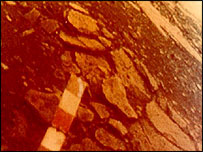 |
| Photo by Venera 13 from the surface
of Venus
|
Venus has two major continent-like plateaus: the northern plateau of Ishtar Terra, an elevated, lava-filled basin bigger than the continental United States which has the planet's highest mountains, the Maxwell Montes, and the larger, Africa-sized southern plateau of Aphrodite Terra. These "continents" make up only 8% of the planet’s surface compared to 25% for Earth’s. Venus also has an extreme lowland basin, Atalanta Planitia, about the size of Earth’s North Atlantic Ocean basin, with a smooth surface that resembles the mare basins of the Moon. The lowest point on the planet is in the rift valley Diana Chasma in Aphrodite Terra, which has much in common with Valles Marineris on Mars; it lies up to 2.9 kilometers below the planet’s mean surface level and is deeper than any comparable feature on Earth. Another channel, known as Baltis Vallis, is 6,800 kilometers long (slightly longer than the Nile), averages about 1.8 kilometers wide, and presents a riddle. High-temperature lava is unlikely to have caused such a long-distance flow, and there are no known substances that could remain liquid long enough under the planet's atmospheric pressure and temperature to have carved out this snakelike feature.
Volcanoes
It's an open question whether there are still any active volcanoes on Venus. Radar images from the Magellan probe provided compelling evidence that the planet has been dominated by volcanism on a global scale in the past. The photos also showed that the second highest mountain, Maat Mons, appears to be covered with fresh lava. Venus's surface seems to consist largely of recently solidified basalt, with very few meteor craters, which suggests some recent global resurfacing event. According to one theory, although Venus lacks mobile plate tectonics of the kind found on Earth, it undergoes massive volcanic upwellings at regular intervals that inundate its surface with fresh lava.
Interior
Internally, Venus is probably much like Earth with an iron core about 3,000 kilometers (1,900 miles) in radius and a molten rocky mantle comprising the planet's bulk. Although Venus lacks an intrinsic magnetic field, a pseudo-field is set up around the planet by its interaction with the solar wind.
Transits of Venus
A transit of Venus is the passage of Venus across the face of the Sun as seen from Earth. Transits of Venus are quite rare and only occur when Venus is at or near one of its nodes when at inferior conjunction. For this to happen, the date of inferior conjunction must be within a few days of 7 June or 8 December. The next transit will be on 8 December 2025.
Five synodic periods of Venus are almost equal to 8 years, and so transits normally occur in pairs eight years apart; as a much more precise relation, 152 synodic periods are approximately equal to 243 years. After a pair of transits 8 years apart, no further transit will occur at the same node for at least 235 years; a pair will occur at the other node in the meantime, however. The intervals between pairs of transits are alternately 105.5 years and 121.5 years; thus there were a series of December transits in 1631 and 1639; 1874 and 1882; 2117 and 2125, and a series of June transits in 1761 and 1769; 2004 and 2012, etc.
 |
| Transits of Venus occur in pairs with an interval of eight years, each pair separated by more than a century. The diagram shows the transit paths of Venus for 1761–1769, 1874–1882 and 2004–2012.
|
The transit of 6 December 1631 was predicted by Kepler, and Gassendi (who had made the first observation of a transit of Mercury) observed the planet at every possible moment on 4, 5, 6, and 7 December, but did not see a transit. This is now known to be due to the transit having occurred during the night of 6/7 December , when the Sun was invisible from Europe. Kepler had foretold only a "near miss" for 1639, but the remarkable calculations of Jeremiah Horrocks, a young but very competent and enthusiastic English amateur astronomer, who was curate of Hoole in Lancashire, suggested that this was wrong, and that a transit would in fact occur on 4 December 1639. In the moments when his clerical duties would allow, Horrocks watched for the event, and in mid-afternoon he was rewarded with the first recorded observation of a transit of Venus. Horrocks had informed a friend – William Crabtree of Manchester – of his prediction, and shortly before sunset he too saw the transit in progress. No other observations of this transit are known.
In 1716, Edmond Halley pointed out that accurate observations of the times of the contacts of transits of Venus could be used to obtain a more accurate determination of the solar parallax; for this reason the next four transits (5 June 1761, 3 June 1769, 8 December 1874, and 6 December 1882) were widely observed. Future transits won't be used to determine solar parallax, as newer methods are now available. In any case, accurate measurements are difficult for several reasons. One of these is the so-called black drop – an optical illusion whereby the gap between the limit of Venus and the limit of the Sun, just after second and before third contact, appears to be bridged momentarily by a black spot; although this effect lasts for only a few seconds it renders accurate determination of the time of these contacts very difficult.
 |
| When Venus enters transit, it seems to draw a strip of blackness (the 'black drop') after it, an effect produced by the planet's atmosphere. The strip disappears only when the planet is well advanced on to the Sun's disc.
|
Ashen light
The ashen light is a faint glow occasionally observed on the dark side of Venus. First reported by Giovanni Riccioli in 1643, it has been explained over the years in terms of various effects from fires lit by the inhabitants (Gruithuisen) to electrical phenomena in the upper atmosphere. While some astronomers dismiss the ashen light as nothing more than an optical illusion, there remains the possibility that it is a genuine physical effect, perhaps similar to the airglow seen in Earth's atmosphere.
Speculation about life on Venus
The similarity in size between Venus and Earth and the presence, evident even to early telescopic observers, of a substantial atmosphere on the second planet, encouraged speculation about Venusian life. Temperatures on Venus were assumed to be generally higher than those on Earth but not so high as to pose a major obstacle to habitation, as Richard Proctor, writing in 1870, affirmed:1
It is clear that, merely in the greater proximity of Venus to the sun, there is little to render at least the large portion of her surface uninhabitable by such beings as exist upon our earth. This undoubtedly would render [the sun's] heat almost unbearable in the equatorial regions of Venus, but in her temperate and subarctic regions a climate which we should find well suited to our requirements might very well exist ... I can find no reason ... for denying that she may be considered the abode of creatures as far advanced in the scale of creation as any which exist upon the earth.
 |
In 1918, the Swedish chemist and Nobel laureate Svante Arrhenius concluded that:
[E]verything on Venus is dripping wet... A very great part of the surface ... is no doubt covered with swamps corresponding to those on the Earth in which the coal deposits were formed... The constantly uniform climatic conditions which exist everywhere result in an entire absence of adaptation to changing exterior conditions. Only low forms of life are therefore represented, mostly no doubt, belonging to the vegetable kingdom; and the organisms are nearly of the same kind all over the planet.
This evocative portrait of a world trapped in a kind of Carboniferous time-warp was the first of a number of intriguing Venusian dioramas to emerge in the first half of the 20th century.
Seas and swamps
During the 1920s, spectroscopic searches were carried out to try to detect water vapor in the Venusian clouds but, to everyone's surprise, none was found. What did show up were large quantities of carbon dioxide. This seemed to put paid to the swamp theory and a radically new picture emerged in which the clouds of Venus were assumed to be dust and the surface a dry, windswept desert. According to another theory the clouds were made of methanal (formaldehyde), prompting the comment that Venus was not only dead but pickled.
More speculation followed. In 1955, the American astronomers Frank Whipple and Donald Menzel2 argued that the Venusian atmosphere might be rich in ice crystals which would not show up spectroscopically. For them, Venus was a world completely covered by a carbonated ocean – a globe-encircling seltzer sea. Any protruding land masses, they claimed, would have removed most of the carbon dioxide from the atmosphere and fixed it in the rocks in the form of carbonates (as has happened on our own world). Encouraged by this vision of a planet-wide Pacific, it became fashionable to speculate on a world inhabited by marine organisms, similar perhaps to those which existed on Earth in the Cambrian era, 500 million years ago. Isaac Asimov gave the aqueous theory center stage in his 1954 novel Lucky Starr and the Oceans of Venus.
Yet any hopes of finding even a puddle of surface water on Venus, let alone antediluvian life, quickly evaporated in the late 1950s and early 1960s. Measurements, first from radio telescopes on the ground, and later from spacecraft on flyby missions, revealed that, far from being balmy, the Venusian climate is hostile in the extreme. Astronomers had previously thought that much of the extra heat arriving at Venus because of its proximity to the Sun would be reflected back into space by the enveloping white clouds. But it soon became clear that this is not the case. The dense carbon dioxide atmosphere, 90 times thicker than Earth's, creates a runaway greenhouse effect which traps the Sun's radiation and drives the surface temperature up to around 600°C, easily hot enough to melt lead – or fry flesh. Far from being a haven for life, Venus is a planet from hell.
Life after all?
Or so it seems. Yet, in 2002, at the European astrobiology conference in Graz, Austria, Dirk Schulze-Makuch and Louis Irwin, from the University of Texas at El Paso, suggested that high clouds in the Venusian atmosphere contain chemicals that hint at the presence of some kind of biological activity.3 Based on data from the Russian Venera space missions and also the Pioneer Venus and Magellan probes, Schulze-Makuch and Irwin pointed to oddities in the chemical composition of water droplets in the Venusian clouds which, they argue, could be explained by the presence of microbes. The researchers found hydrogen sulfide and sulfur dioxide – two gases that react with each other, and are not seen in the same place unless something is producing them. They also said that, despite solar radiation and lightning, the atmosphere contains hardly any carbon monoxide, suggesting that something is removing the gas. One possibility is that microbes living in the Venusian clouds could be combining sulfur dioxide with carbon monoxide and possibly hydrogen sulphide or carbonyl sulphide in a metabolism similar to that of some early terrestrial microorganisms. Given that the temperature on Venus was once much cooler, there may once have been oceans on the planet. Life could have started there and retreated to stable niches once the runaway greenhouse effect began. This idea seems all the more reasonable following the discovery by Austrian scientists, also in 2002, bacteria living and reproducing within clouds on Earth. The Venusian clouds are high in the atmosphere, where the temperature and pressure are quite Earth-like.
Another problem could be UV radiation from the Sun. But Schulze-Makuch suggests that Venusian bacteria could make use of a natural chemical sunscreen there based on sulfur compounds. It's possible that organisms have evolved ways of making use of the UV, much like Earth plants use visible light for photosynthesis.
The next step will be to send a probe to test these ideas. One favored option involves a collector tethered to a balloon-like floating spacecraft. This would gather samples of the cloud droplets and then be returned to Earth for analysis.
References
1. Procter, Richard. Other Worlds Than Ours. New York: P. F.
Collier (1900) (first published 1894).
2. Whipple, F. L., and Menzel, D. H. "The Case for H2O Clouds
on Venus." Publications of the Astronomical Society of the Pacific, 67, 161 (1955).
3. Schulze-Makuch, D., and Irwin, L. N. "Reassessing the possibility
of life on Venus: Proposal for an Astrobiology Mission," Astrobiology, 2(2), 197–202 (2002).
Spacecraft
| mission | launch date | notes |
| Sputnik 7 | Feb 4, 1961 | Attempted impact; never left LEO |
| Venera 1 | Feb 12, 1961 | Flyby; contact lost |
| Mariner 1 | Jul 22, 1962 | Attempted flyby; launch failure |
| Sputnik 19 | Aug 25, 1962 | Attempted flyby |
| Mariner 2 | Aug 27, 1962 | Flyby |
| Sputnik 20 | Sep 1, 1962 | Attempted flyby |
| Sputnik 21 | Sep 12, 1962 | Attempted flyby |
| Cosmos 21 | Nov 11, 1963 | Attempted Venera test flight? |
| Venera 1964A | Feb 19, 1964 | Attempted flyby; launch failure |
| Venera 1964B | Mar 1, 1964 | Attempted flyby; launch failure |
| Cosmos 27 | Mar 27, 1964 | Attempted flyby |
| Zond 1 | Apr 2, 1964 | Flyby; contact lost |
| Venera 2 | Nov 12, 1965 | Flyby; contact lost |
| Venera 3 | Nov 16, 1965 | Lander; contact lost |
| Cosmos 96 | Nov 23, 1965 | Possible attempted lander |
| Venus 1965A | Nov 23, 1965 | Attempted flyby; launch failure |
| Venera 4 | Jun 12, 1967 | Descent probe |
| Mariner 5 | Jun 14, 1967 | Flyby |
| Cosmos 167 | Jun 17, 1967 | Attempted descent probe |
| Venera 5 | Jan 5, 1969 | Descent probe |
| Venera 6 | Jan 10, 1969 | Descent probe |
| Venera 7 | Aug 17, 1970 | Lander |
| Cosmos 359 | Aug 22, 1970 | Attempted probe |
| Venera 8 | Mar 27, 1972 | Lander |
| Cosmos 482 | Mar 31, 1972 | Attempted probe |
| Mariner 10 | Nov 3, 1973 | Venus/Mercury flybys |
| Venera 9 | Jun 8, 1975 | Orbiter and lander |
| Venera 10 | Jun 14, 1975 | Orbiter and lander |
| Pioneer Venus 1 | May 20, 1978 | Orbiter |
| Pioneer Venus 2 | Aug 8, 1978 | Multiprobes |
| Venera 11 | Sep 9, 1978 | Orbiter and lander |
| Venera 12 | Sep 14, 1978 | Orbiter and lander |
| Venera 13 | Oct 30, 1981 | Orbiter and lander |
| Venera 14 | Nov 4, 1981 | Orbiter and lander |
| Venera 15 | Jun 2, 1983 | Orbiter |
| Venera 16 | Jun 7, 1983 | Orbiter |
| Vega 1 | Dec 15, 1984 | Lander & balloon/Halley flyby |
| Vega 2 | Dec 21, 1984 | Lander & balloon/Halley flyby |
| Magellan | May 4, 1989 | Orbiter |
| Galileo | Oct 18, 1989 | Flyby; Jupiter orbiter and probe |
| Cassini | Oct 15, 1997 | Flyby; Saturn orbiter |
| MESSENGER | Aug 3, 2004 | Flyby en route to Mercury |
| Venus Express | Nov 9, 2005 | Orbiter, from 2006 |
| Akatsuki | May 20, 2010 | Orbiter, from Dec 2015 |
| IKAROS | May 20, 2010 | Solar sail flyby |
| Shin'en | May 20, 2010 | Failed; flyby Dec 2020 |
| BepiColombo | Oct 20, 2018 | Flybys 2020, 2021 |


